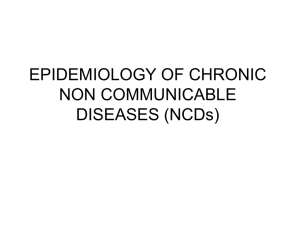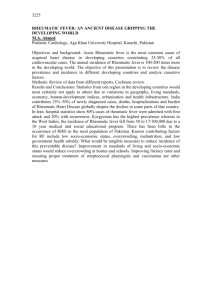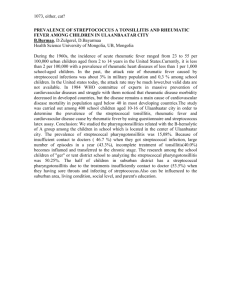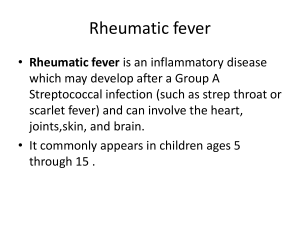Cardiovascular
advertisement
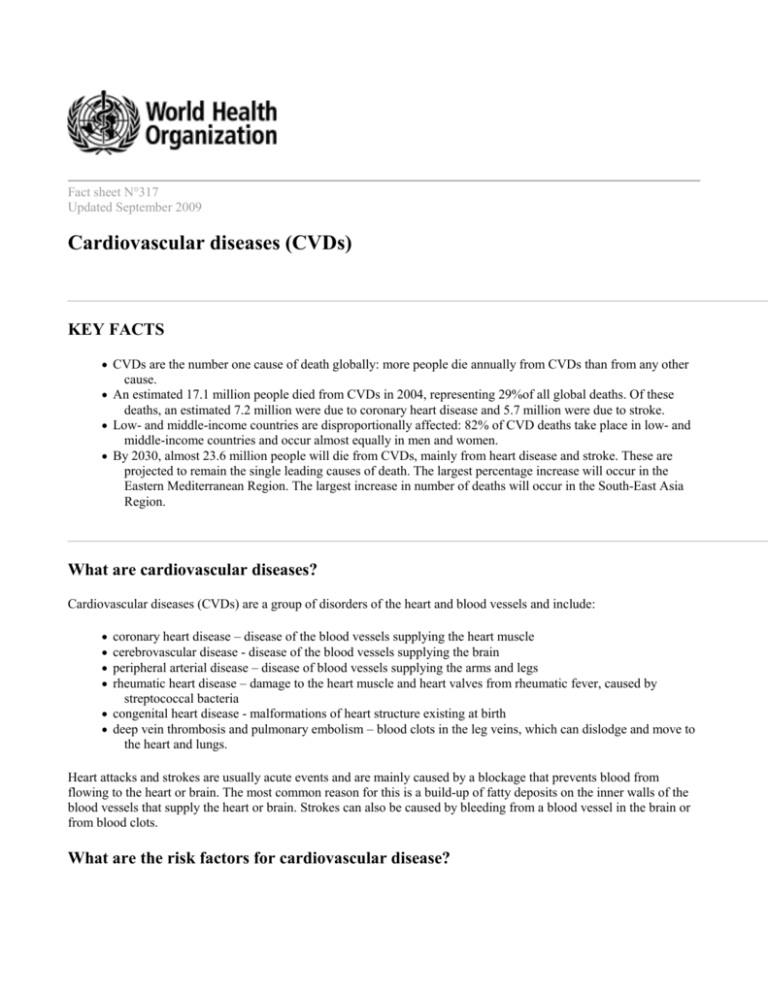
Fact sheet N°317 Updated September 2009 Cardiovascular diseases (CVDs) KEY FACTS CVDs are the number one cause of death globally: more people die annually from CVDs than from any other cause. An estimated 17.1 million people died from CVDs in 2004, representing 29%of all global deaths. Of these deaths, an estimated 7.2 million were due to coronary heart disease and 5.7 million were due to stroke. Low- and middle-income countries are disproportionally affected: 82% of CVD deaths take place in low- and middle-income countries and occur almost equally in men and women. By 2030, almost 23.6 million people will die from CVDs, mainly from heart disease and stroke. These are projected to remain the single leading causes of death. The largest percentage increase will occur in the Eastern Mediterranean Region. The largest increase in number of deaths will occur in the South-East Asia Region. What are cardiovascular diseases? Cardiovascular diseases (CVDs) are a group of disorders of the heart and blood vessels and include: coronary heart disease – disease of the blood vessels supplying the heart muscle cerebrovascular disease - disease of the blood vessels supplying the brain peripheral arterial disease – disease of blood vessels supplying the arms and legs rheumatic heart disease – damage to the heart muscle and heart valves from rheumatic fever, caused by streptococcal bacteria congenital heart disease - malformations of heart structure existing at birth deep vein thrombosis and pulmonary embolism – blood clots in the leg veins, which can dislodge and move to the heart and lungs. Heart attacks and strokes are usually acute events and are mainly caused by a blockage that prevents blood from flowing to the heart or brain. The most common reason for this is a build-up of fatty deposits on the inner walls of the blood vessels that supply the heart or brain. Strokes can also be caused by bleeding from a blood vessel in the brain or from blood clots. What are the risk factors for cardiovascular disease? The most important behavioural risk factors of heart disease and stroke are unhealthy diet, physical inactivity and tobacco use. Behavioural risk factors are responsible for about 80% of coronary heart disease and cerebrovascular disease. The effects of unhealthy diet and physical inactivity may show up in individuals as raised blood pressure, raised blood glucose, raised blood lipids, and overweight and obesity; these are called 'intermediate risk factors'. There are also a number of underlying determinants of CVDs, or, if you like, "the causes of the causes". These are a reflection of the major forces driving social, economic and cultural change – globalization, urbanization, and population ageing. Other determinants of CVDs are poverty and stress. What are common symptoms of cardiovascular diseases? Symptoms of heart attacks and strokes Often, there are no symptoms of the underlying disease of the blood vessels. A heart attack or stroke may be the first warning of underlying disease. Symptoms of a heart attack include: pain or discomfort in the centre of the chest; pain or discomfort in the arms, the left shoulder, elbows, jaw, or back. In addition the person may experience difficulty in breathing or shortness of breath; feeling sick or vomiting; feeling light-headed or faint; breaking into a cold sweat; and becoming pale. Women are more likely to have shortness of breath, nausea, vomiting, and back or jaw pain. The most common symptom of a stroke is sudden weakness of the face, arm, or leg, most often on one side of the body. Other symptoms include sudden onset of: numbness of the face, arm, or leg, especially on one side of the body; confusion, difficulty speaking or understanding speech; difficulty seeing with one or both eyes; difficulty walking, dizziness, loss of balance or coordination; severe headache with no known cause; and fainting or unconsciousness. People experiencing these symptoms should seek medical care immediately. What is rheumatic heart disease? Rheumatic heart disease is caused by damage to the heart valves and heart muscle from the inflammation and scarring caused by rheumatic fever. Rheumatic fever is caused by streptococcal bacteria, which usually begins as a sore throat or tonsillitis in children. Rheumatic fever mostly affects children in developing countries, especially where poverty is widespread. Globally, almost 2% of deaths from cardiovascular diseases is related to rheumatic heart disease, while 42% of deaths from cardiovascular diseases is related to ischaemic heart disease, and 34% to cerebrovascular disease. Symptoms of rheumatic heart disease Symptoms of rheumatic heart disease include: shortness of breath, fatigue, irregular heart beats, chest pain and fainting. Symptoms of rheumatic fever include: fever, pain and swelling of the joints, nausea, stomach cramps and vomiting. Treatment Early treatment of streptococcal sore throat can stop the development of rheumatic fever. Regular long-term penicillin treatment can prevent repeat attacks of rheumatic fever which give rise to rheumatic heart disease and can stop disease progression in people whose heart valves are already damaged by the disease. Why are cardiovascular diseases a development issue in low- and middle-income countries? Over 80% of the world's deaths from CVDs occur in low- and middle-income countries. People in low- and middle-income countries are more exposed to risk factors leading to CVDs and other noncommunicable diseases and are less exposed to prevention efforts than people in high-income countries. People in low- and middle-income countries who suffer from CVDs and other noncommunicable diseases have less access to effective and equitable health care services which respond to their needs (including early detection services). As a result, many people in low- and middle-income countries die younger from CVDs and other noncommunicable diseases, often in their most productive years. The poorest people in low- and middle-income countries are affected most. At household level, sufficient evidence is emerging to prove that CVDs and other noncommunicable diseases contribute to poverty. For example, catastrophic health care expenditures for households with a family member with CVD can be 30 per cent or more of annual household spending. At macro-economic level, CVDs place a heavy burden on the economies of low- and middle-income countries. Heart disease, stroke and diabetes are estimated to reduce GDP between 1 and 5% in low- and middleincome countries experiencing rapid economic growth, as many people die prematurely. For example, it is estimated that over the next 10 years (2006-2015), China will lose $558 billion in foregone national income due to the combination of heart disease, stroke and diabetes. How can the burden of cardiovascular diseases be reduced? Heart disease and stroke can be prevented through healthy diet, regular physical activity and avoiding tobacco smoke. Individuals can reduce their risk of CVDs by engaging in regular physical activity, avoiding tobacco use and secondhand tobacco smoke, choosing a diet rich in fruit and vegetables and avoiding foods that are high in fat, sugar and salt, and maintaining a healthy body weight. Comprehensive and integrated action is the means to prevent and control CVDs. Comprehensive action requires combining approaches that seek to reduce the risks throughout the entire population with strategies that target individuals at high risk or with established disease. Examples of population-wide interventions that can be implemented to reduce CVDs include: comprehensive tobacco control policies, taxation to reduce the intake of foods that are high in fat, sugar and salt, building walking and cycle ways to increase physical activity, providing healthy school meals to children. Integrated approaches focus on the main common risk factors for a range of chronic diseases such as CVD, diabetes and cancer: unhealthy diet, physically inactivity and tobacco use. There are several treatment options available. Effective and inexpensive medication is available to treat nearly all CVDs. Survivors of a heart attack or stroke are at high risk of recurrences and at high risk of dying from them. The risk of a recurrence or death can be substantially lowered with a combination of drugs – statins to lower cholesterol, drugs to lower blood pressure, and aspirin. Operations used to treat CVDs include coronary artery bypass, balloon angioplasty (where a small balloon-like device is threaded through an artery to open the blockage), valve repair and replacement, heart transplantation, and artificial heart operations. Medical devices are required to treat some CVDs. Such devices include pacemakers, prosthetic valves, and patches for closing holes in the heart. There is a need for increased government investment through national programmes aimed at prevention and control of CVDs and other noncommunicable diseases. For more information contact: WHO Media centre Telephone: +41 22 791 2222 E-mail: mediainquiries@who.int
